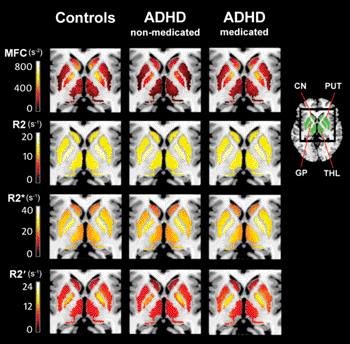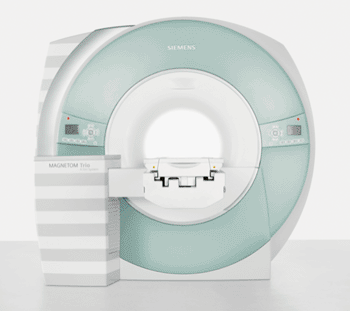Magnetic Field Correlation MRI Reveals Low Brain Iron in ADHD Patients
|
By MedImaging International staff writers Posted on 17 Dec 2013 |

Image: Medication-naïve ADHD patients (ADHD-nonmedicated) have reduced striatal (putamen (PUT), caudate nucleus (CN)) and thalamic (THL) magnetic field correlation (MFC) measures of brain iron compared to controls and psychostimulant medicated ADHD patients (ADHD-medicated); Brain iron measures in PUT, CN, THL or globus pallidus (GP) did not differ between controls and psychostimulant medicated ADHD patients. These statistical significant differences are visible in the MFC group maps (top row) but not in conventional relaxation rate maps: R2 (second row), R2*(third row), and R2\' (bottom row) (Photo courtesy of RSNA).

Image: Photograph of a Siemens Healthcare (Erlangen, Germany) Magnetom Trio MRI scanner (Photo courtesy of RSNA).
A new magnetic resonance imaging (MRI) technique offers a noninvasive way to measure iron levels in the brains of individuals with attention deficit hyperactivity disorder (ADHD).
The new findings were presented December 2013 at the annual meeting of the Radiological Society of North America (RSNA), held in Chicago (IL, USA). Researchers reported that the imaging technology could help physicians and parents make better informed decisions about medication.
ADHD is a common disorder in children and adolescents that can continue into adulthood. Symptoms include hyperactivity and difficulty staying focused, paying attention, and controlling behavior. The American Psychiatric Association reports that ADHD affects 3%–7% of school-age children.
Psychostimulant drugs such as Ritalin are among the drugs typical used to decrease ADHD symptoms. Psychostimulants affect levels of dopamine, a neurotransmitter in the brain associated with addiction. “Studies show that psychostimulant drugs increase dopamine levels and help the kids that we suspect have lower dopamine levels,” said Vitria Adisetiyo, PhD, postdoctoral research fellow at the Medical University of South Carolina (Charleston, SC, USA). “As brain iron is required for dopamine synthesis, assessment of iron levels with MRI may provide a noninvasive, indirect measure of dopamine.”
Dr. Adisetiyo and colleagues explored this possibility by measuring brain iron in 22 children and adolescents with ADHD and 27 healthy control children and adolescents employing an MRI technique called magnetic field correlation (MFC) imaging. The technique is comparatively new, having been introduced in 2006 by study coauthors and faculty members Joseph A. Helpern, PhD, and Jens H. Jensen, PhD. “MRI relaxation rates are the more conventional way to measure brain iron, but they are not very specific,” Dr. Adisetiyo said. “We added MFC because it offers more refined specificity.”
The findings demonstrated that the 12 ADHD patients who had never been on medication had substantially lower MFC than the 10 ADHD patients who had been on psychostimulant drugs or the 27 typically developing children and adolescents in the control group. In contrast, no significant group differences were detected using relaxation rates or serum measures. The lower brain iron levels in the nonmedicated group appeared to normalize with psychostimulant medication.
MFC imaging’s ability to identify noninvasively the low iron levels may help improve ADHD diagnosis and guide optimal treatment. Noninvasive techniques are especially important in a pediatric population, Dr. Adisetiyo noted. “This method enables us to exploit inherent biomarkers in the body and indirectly measure dopamine levels without needing any contrast agent,” she said.
If the findings can be repeated in larger studies, then MFC might have a future role in determining which patients would benefit from psychostimulants—an important consideration because the drugs can become addictive in some patients and lead to abuse of other psychostimulant drugs such as cocaine. “It would be beneficial when the psychiatrist is less confident of a diagnosis if you could put a patient in a scanner for 15 minutes and confirm that brain iron is low,” she concluded. “And we could possibly identify kids with normal iron levels who could potentially become addicts.”
Combined with replicating the findings in a larger population of patients, the researchers plan to expand their studies to look at the relationship between cocaine addiction and brain iron.
Related Links:
Medical University of South Carolina
The new findings were presented December 2013 at the annual meeting of the Radiological Society of North America (RSNA), held in Chicago (IL, USA). Researchers reported that the imaging technology could help physicians and parents make better informed decisions about medication.
ADHD is a common disorder in children and adolescents that can continue into adulthood. Symptoms include hyperactivity and difficulty staying focused, paying attention, and controlling behavior. The American Psychiatric Association reports that ADHD affects 3%–7% of school-age children.
Psychostimulant drugs such as Ritalin are among the drugs typical used to decrease ADHD symptoms. Psychostimulants affect levels of dopamine, a neurotransmitter in the brain associated with addiction. “Studies show that psychostimulant drugs increase dopamine levels and help the kids that we suspect have lower dopamine levels,” said Vitria Adisetiyo, PhD, postdoctoral research fellow at the Medical University of South Carolina (Charleston, SC, USA). “As brain iron is required for dopamine synthesis, assessment of iron levels with MRI may provide a noninvasive, indirect measure of dopamine.”
Dr. Adisetiyo and colleagues explored this possibility by measuring brain iron in 22 children and adolescents with ADHD and 27 healthy control children and adolescents employing an MRI technique called magnetic field correlation (MFC) imaging. The technique is comparatively new, having been introduced in 2006 by study coauthors and faculty members Joseph A. Helpern, PhD, and Jens H. Jensen, PhD. “MRI relaxation rates are the more conventional way to measure brain iron, but they are not very specific,” Dr. Adisetiyo said. “We added MFC because it offers more refined specificity.”
The findings demonstrated that the 12 ADHD patients who had never been on medication had substantially lower MFC than the 10 ADHD patients who had been on psychostimulant drugs or the 27 typically developing children and adolescents in the control group. In contrast, no significant group differences were detected using relaxation rates or serum measures. The lower brain iron levels in the nonmedicated group appeared to normalize with psychostimulant medication.
MFC imaging’s ability to identify noninvasively the low iron levels may help improve ADHD diagnosis and guide optimal treatment. Noninvasive techniques are especially important in a pediatric population, Dr. Adisetiyo noted. “This method enables us to exploit inherent biomarkers in the body and indirectly measure dopamine levels without needing any contrast agent,” she said.
If the findings can be repeated in larger studies, then MFC might have a future role in determining which patients would benefit from psychostimulants—an important consideration because the drugs can become addictive in some patients and lead to abuse of other psychostimulant drugs such as cocaine. “It would be beneficial when the psychiatrist is less confident of a diagnosis if you could put a patient in a scanner for 15 minutes and confirm that brain iron is low,” she concluded. “And we could possibly identify kids with normal iron levels who could potentially become addicts.”
Combined with replicating the findings in a larger population of patients, the researchers plan to expand their studies to look at the relationship between cocaine addiction and brain iron.
Related Links:
Medical University of South Carolina
Latest MRI News
- Simple Brain Scan Diagnoses Parkinson's Disease Years Before It Becomes Untreatable
- Cutting-Edge MRI Technology to Revolutionize Diagnosis of Common Heart Problem
- New MRI Technique Reveals True Heart Age to Prevent Attacks and Strokes
- AI Tool Predicts Relapse of Pediatric Brain Cancer from Brain MRI Scans
- AI Tool Tracks Effectiveness of Multiple Sclerosis Treatments Using Brain MRI Scans
- Ultra-Powerful MRI Scans Enable Life-Changing Surgery in Treatment-Resistant Epileptic Patients
- AI-Powered MRI Technology Improves Parkinson’s Diagnoses
- Biparametric MRI Combined with AI Enhances Detection of Clinically Significant Prostate Cancer
- First-Of-Its-Kind AI-Driven Brain Imaging Platform to Better Guide Stroke Treatment Options
- New Model Improves Comparison of MRIs Taken at Different Institutions
- Groundbreaking New Scanner Sees 'Previously Undetectable' Cancer Spread
- First-Of-Its-Kind Tool Analyzes MRI Scans to Measure Brain Aging
- AI-Enhanced MRI Images Make Cancerous Breast Tissue Glow
- AI Model Automatically Segments MRI Images
- New Research Supports Routine Brain MRI Screening in Asymptomatic Late-Stage Breast Cancer Patients
- Revolutionary Portable Device Performs Rapid MRI-Based Stroke Imaging at Patient's Bedside
Channels
Radiography
view channel
Machine Learning Algorithm Identifies Cardiovascular Risk from Routine Bone Density Scans
A new study published in the Journal of Bone and Mineral Research reveals that an automated machine learning program can predict the risk of cardiovascular events and falls or fractures by analyzing bone... Read more
AI Improves Early Detection of Interval Breast Cancers
Interval breast cancers, which occur between routine screenings, are easier to treat when detected earlier. Early detection can reduce the need for aggressive treatments and improve the chances of better outcomes.... Read more
World's Largest Class Single Crystal Diamond Radiation Detector Opens New Possibilities for Diagnostic Imaging
Diamonds possess ideal physical properties for radiation detection, such as exceptional thermal and chemical stability along with a quick response time. Made of carbon with an atomic number of six, diamonds... Read moreUltrasound
view channel
New Incision-Free Technique Halts Growth of Debilitating Brain Lesions
Cerebral cavernous malformations (CCMs), also known as cavernomas, are abnormal clusters of blood vessels that can grow in the brain, spinal cord, or other parts of the body. While most cases remain asymptomatic,... Read more.jpeg)
AI-Powered Lung Ultrasound Outperforms Human Experts in Tuberculosis Diagnosis
Despite global declines in tuberculosis (TB) rates in previous years, the incidence of TB rose by 4.6% from 2020 to 2023. Early screening and rapid diagnosis are essential elements of the World Health... Read moreNuclear Medicine
view channel
Novel Radiolabeled Antibody Improves Diagnosis and Treatment of Solid Tumors
Interleukin-13 receptor α-2 (IL13Rα2) is a cell surface receptor commonly found in solid tumors such as glioblastoma, melanoma, and breast cancer. It is minimally expressed in normal tissues, making it... Read more
Novel PET Imaging Approach Offers Never-Before-Seen View of Neuroinflammation
COX-2, an enzyme that plays a key role in brain inflammation, can be significantly upregulated by inflammatory stimuli and neuroexcitation. Researchers suggest that COX-2 density in the brain could serve... Read moreGeneral/Advanced Imaging
view channel
First-Of-Its-Kind Wearable Device Offers Revolutionary Alternative to CT Scans
Currently, patients with conditions such as heart failure, pneumonia, or respiratory distress often require multiple imaging procedures that are intermittent, disruptive, and involve high levels of radiation.... Read more
AI-Based CT Scan Analysis Predicts Early-Stage Kidney Damage Due to Cancer Treatments
Radioligand therapy, a form of targeted nuclear medicine, has recently gained attention for its potential in treating specific types of tumors. However, one of the potential side effects of this therapy... Read moreImaging IT
view channel
New Google Cloud Medical Imaging Suite Makes Imaging Healthcare Data More Accessible
Medical imaging is a critical tool used to diagnose patients, and there are billions of medical images scanned globally each year. Imaging data accounts for about 90% of all healthcare data1 and, until... Read more
Global AI in Medical Diagnostics Market to Be Driven by Demand for Image Recognition in Radiology
The global artificial intelligence (AI) in medical diagnostics market is expanding with early disease detection being one of its key applications and image recognition becoming a compelling consumer proposition... Read moreIndustry News
view channel
GE HealthCare and NVIDIA Collaboration to Reimagine Diagnostic Imaging
GE HealthCare (Chicago, IL, USA) has entered into a collaboration with NVIDIA (Santa Clara, CA, USA), expanding the existing relationship between the two companies to focus on pioneering innovation in... Read more
Patient-Specific 3D-Printed Phantoms Transform CT Imaging
New research has highlighted how anatomically precise, patient-specific 3D-printed phantoms are proving to be scalable, cost-effective, and efficient tools in the development of new CT scan algorithms... Read more
Siemens and Sectra Collaborate on Enhancing Radiology Workflows
Siemens Healthineers (Forchheim, Germany) and Sectra (Linköping, Sweden) have entered into a collaboration aimed at enhancing radiologists' diagnostic capabilities and, in turn, improving patient care... Read more




















